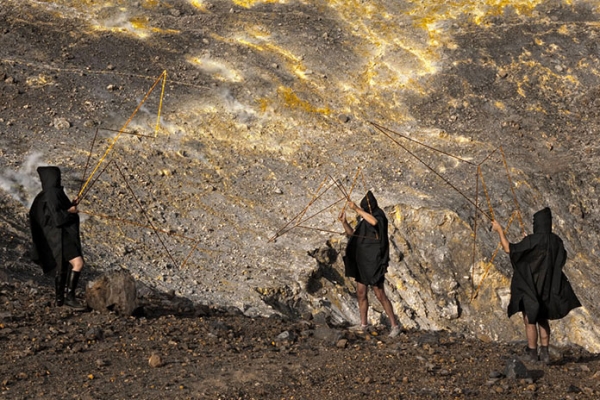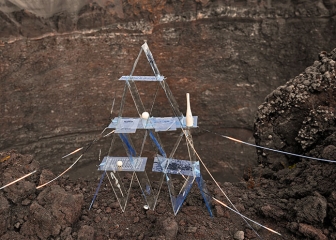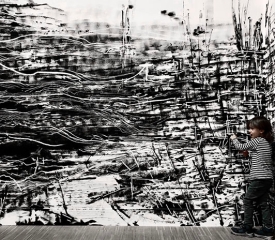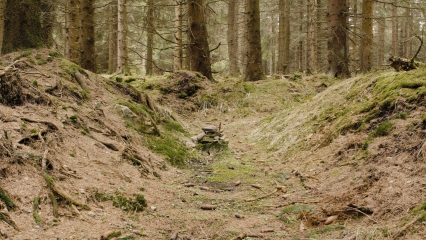„Climate Dignity“
umfasst die Idee, dass alle Menschen das Recht haben, in einer Welt zu leben, in der ihre Gesundheit, ihre Freiheit und ihre
Lebensgrundlagen nicht durch den Klimawandel bedroht sind. Im Sinne der Klimagerechtigkeit gilt dies insbesondere für diejenigen
Personen, Gemeinschaften und Länder, die am stärksten vom Klimawandel betroffen sind oder wahrscheinlich betroffen sein werden
und daher besonders schutzbedürftig sind. Gleichzeitig betont Climate Dignity, dass die Folgen des vom Menschen verursachten
Klimawandels und der damit verbundene Verlust der Biodiversität nicht nur die Menschenwürde, sondern auch die Natur gefährden.
Das Konzept, das Climate Dignity zugrunde liegt, stellt die mehr-als-menschlichen Beziehungen in den Mittelpunkt und betont
die gegenseitige Abhängigkeit von Mensch und Natur: Die Würde der Natur zu verletzen bedeutet, die Menschenwürde zu verletzen.
Diese Gruppenausstellung im Künstlerhaus Wien versteht „Climate Dignity“ als Aufruf zum Handeln. Die von den teilnehmenden
Künstlerinnen und Künstlern durchgeführten Recherchen und die daraus resultierenden Werke sollen uns alle mit Wissen und Mut
ausstatten, um der anhaltenden Zerstörung unserer Welt zu widerstehen.
Die folgenden Künstler*innen und Kollektive
sind vertreten und lehren und/oder forschen auch an der Universität für angewandte Kunst Wien: Andreas Duscha, Ernst Logar,
Shaken Grounds, Christoph Höschele.
Andreas Duscha, Radenko Milak
COP
Shaken Grounds
Shaken Grounds, Shifting Skies
The PEEK-project Shaken Grounds is represented at
the exhibition by an intermedial installation
with a wall drawing, objects, painings and video works
by Nikolaus Gansterer,
Mariella Greil, Peter Kozek, and Lucie Strecker,
in collaboration with Victor Jaschke and Werner Moebius.
With additional
artistic and scientific contributions by Valerio Acocella, Arno Böhler,
Oscar Fernandez Bellon, Helga Franza, Sabine Folie,
Nicolas Freytag, Nicola Fornoni,
Sylvia Scheidl, and VestAndPage (Andrea Pagnes / Verena Stenke).
“The geo-philosopher
moves along the crest of turbulence,
on the shoulders of waves that envelop mind, energy, and matter,
and that diffuse them
into the atmosphere.” (Gilles Deleuze, 1993)
Even before the Anthropocene, disruptive geological forces
were compelling artists
to reflect on the fragility of existence and the origins of their age. Such events raised
fundamental
questions about where to ground reason when the conditions of life could
shift so radically. Natural disasters—like the earthquakes
and volcanic eruptions in southern Italy
—have long served as focal points for both scientific inquiry and artistic reflection.
According to the myth of Rome's founding, Aeneas entered the underworld through
the trembling Phlegraean Fields—surrounded
now by Europe’s largest illegal toxic dump—
to seek guidance on where to settle after his long journey.
On the other
hand, the major eruption of Mount Vesuvius in 79 CE was associated with
the sudden threats posed by the Iron Age, a period
marked by austerity and wars
that prompted a range of artistic responses.
Today, areas prone to seismic activity
are
influencing artistic research and expression in a different way. While such places once
connected people to a poly-temporal
world view, they now bear the weight of new,
man-made pressures. Global warming, groundwater extraction, resource mining,
clean energy technologies, and waste disposal are all increasing the strain on the Earth’s crust,
resulting in human-accelerated
earthquakes. This almost incomprehensible, yet undeniable
phenomenon highlights the complexity of the ecological crisis,
revealing disturbing
new entanglements between humanity and the environment.
The artist collective Shaken Grounds
revisits the continental margins of southern Italy,
exploring the intersections of natural seismic activity and anthropogenic
environmental damage
through an interwoven mesh of artistic experiments. They recognize that the trembling of the earth,
once regarded as one of Gaia’s natural forces, is now being driven by human interference as well.
Art, as research and practice,
excels in detecting and expressing the changing relationship
between humanity and our evolving, technologically influenced,
and highly damaged geological environment.
On April 11, 2025, 16:00–19:00 a "mini symposium" with short lectures,
performance,
and audience discussion on the recording of geological, social, and psychological tremors with
Arno Böhler
(philosopher), Daniel Brandlechner (literary scholar), Nikolaus Gansterer (artist),
Mariella Greil (choreographer and dancer),
Victor Jaschke (filmmaker),
Peter Kozek (artist), and Lucie Strecker (artist) takes place.
Shaken Grounds is
funded by PEEK program of the Austrian Science Fund Austria.
Ernst Logar, Kinga Kiełczyńska
Everyday
Fairy TaleThe exhibtion IMAGINE CLIMATE DIGNITY
is Co-curated by Barbara Hoeller and Simon
Mraz.
A joint project of the Section for International Cultural Affairs in the Ministry
of Foreign Affairs, the Austrian
Cultural Forums, and the Kuenstlerhaus Association.
See all participating artists at
imagineclimatedignity.at/en/about
Christoph Höschele’s work is an experimental exploration of the catchment area of the Bílina River in Northern
Bohemia. He went on multi-day trips in the area to examine nature and visible human impact on it using film.
He used
the collected material to create a large-format video piece that, in a no-comments style, shows the manifestations of the
Bílina from source to delta.







